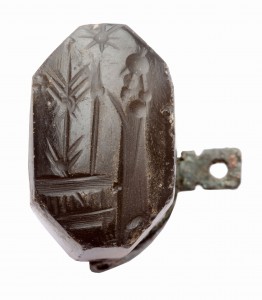
Late Babylonian seal depicting a praying man in front of divine symbols
Source: Forschungsstelle Asia Minor
Most Core students start off with Classical antiquity and its myriad cultures.
Integral to those cultures is their art, and we keep digging up more of it! Take, for example, the massive discovery of more than six hundred ancient seals and amulets in a sanctuary in Turkey, at the sacred site of the storm and weather god Jupiter Dolichenus.
“Such large amounts of seal consecrations are unheard-of in any comparable sanctuary”, said excavation director Prof. Dr. Engelbert Winter and archaeologist Dr. Michael Blömer at the end of the excavation season. In this respect, the finding of numerous pieces from the 7th to the 4th centuries B.C. close to the ancient city of Doliche is unparalleled.
“The amazingly large number proves how important seals and amulets were for the worshipping of the god to whom they were consecrated as votive offerings”, according to Classical scholar Prof. Winter. Many pieces show scenes of adoration. “Thus, they provide a surprisingly vivid and detailed insight into the faith of the time.” The stamp seals and cylinder seals as well as scarabs, made of glass, stone and quartz ceramics, were mostly crafted in a high-quality manner. Following the restoration work, the finds were handed over to the relevant museum in Gaziantep in Turkey.
Up to now, the researchers were able to identify late Babylonian, local Syrian Achaemenid and Levantine seals. “The large find provides new impetus for research to answer unsolved questions of cult practices, cult continuity and cult extension – above all, these are important for the understanding of the early history of the sanctuary in the 1st millennium B.C., which had been unknown until recently”, according to Prof. Winter. Later, in the 2nd century A.D., Jupiter Dolichenus turned into one of the most important deities of the Roman Empire.
To read on, visit the full article.
Also: don’t forget that your BU ID grants you free entry into the MFA (a mere 20 minute walk away from campus), where you can experience treasures such as the ones described above.
